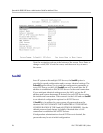
Configuring the SpectraLink 8000 SVP Server
PN: 1725-36031-001_H.doc
31
SVP-II Master
The master SVP Server must be identified in an IP system. Select one
of the following identification options:
• Statically configure the IP address of the master SVP Server in
each of the SVP Servers. Enter the IP address.
See the Overview section for an explanation of the master SVP
Server.
• Statically configure the IP address of the master SVP Server in a
DHCP server and configure each of the SVP Servers to get the
information from the DHCP server. Enter DHCP. If DHCP is
used, the IP address of the master SVP Server must be configured
in the DHCP server. See the wireless telephone interface
document for your IP environment for more information about
DHCP integration factors.
• Statically configure the IP address of the master SVP Server in a
DNS server and configure the each of the SVP Servers to retrieve
this information from the DNS server. Enter DNS. If DNS is used,
the IP address of the master SVP Server must be configured in the
DNS server.
First Alias IP Address/Last Alias IP Address
The SVP Server uses an IP address when acting as a proxy for the
wireless telephone. Therefore, one alias IP address is required for
every installed SpectraLink 8000 Wireless Telephone. These IP
addresses must be entered as a range and must be assigned solely for
this purpose.
When multiple SVP100 Servers are installed, a different range must be
configured in each SVP Server. In determining how many addresses
to configure per SVP Server, use this formula: (# of handsets / # of
SVP Servers) + 30%. This formula will accommodate the possibility of
unequal distribution of handsets among the available SVP Servers.
All alias addresses must be on the same subnet as the SVP Server
and cannot be duplicated on other subnets or SVP Servers. There
is no limit to the number of addresses that can be assigned, but the
capacity of each SVP Server is 500 wireless telephones.


















